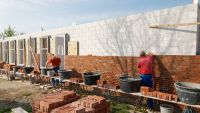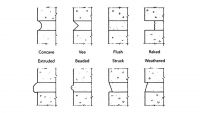Outcome of Masonry Industry Issues at Code Hearings
The International Code Council (ICC) hearings were completed in Detroit on Oct. 1 and 2, and we now know what will appear in the 2006 editions of the International Building Code (IBC), the International Residential Code (IRC), the International Energy Conservation Code (IECC) and other model codes published by the ICC. The Masonry Alliance for Codes and Standards (MACS) was represented at these hearings through our consultants, as well as several masonry and concrete organizations, with the goal of advancing the safe and economical use of masonry materials in the built environment.
The purpose of this article is to provide you within information about the results of these hearings and how those outcomes may affect the masonry industry. While a total of several thousand changes and modifications have been acted on by the ICC in updating these codes, the following items may have the most direct impact.
Revisions to the International Building Code (IBC):
The 2005 MSJC Code and Specification was adopted by reference into the 2006 IBC and International Residential Code (IRC). There were three modifications made to the MSJC in its adoption ? lap splice requirements, AAC masonry and veneer seismic detailing.
- Masonry lap splices
The lap splice design requirements for masonry were revised to be more consistent with historical lap splice design requirements of the Uniform Building Code. The required length of lap is limited to 72 bar diameters for strength design. For allowable stress design, the length of lap is 48 bar diameters, with a 50% increase in lap length for highly stressed regions. These required lap splice lengths are, in general, less than required by the 2005 MSJC and the 2003 IBC and are more simplistic to calculate. Lap splice lengths are expected to be reviewed in more detail in future standards and code hearings. - Aerated autoclaved concrete (AAC)
AAC masonry as a construction material was first introduced with the publication of the 2005 MSJC. While the MSJC contains design and detailing requirements for AAC masonry for all seismic design categories (SDC), the IBC arbitrarily limited its use as a loadbearing shear wall assembly to SDC A only in commercial applications. - Veneer seismic detailing
Based upon an analytical study funded in part by MACS, the 2005 MSJC veneer detailing provisions were revised to remove the required use of bed joint reinforcement in seismic design category SDC D. In its adoption of the MSJC, the IBC reintroduced that same requirement and further required that the wire be mechanically attached to the backup ties in SDC D and higher. - Gravel ballasted roofing systems
During hurricanes and other high wind events, one significant source of damage comes from flying debris ? sometimes this includes flying gravel blown off of gravel ballasted roofing systems. A change that would have reduced the required size of gravel ballast was denied, recognizing that large stone and tile is a far more effective and safe ballast system in regions of the country subjected to high winds. This change opens a potential revitalized market for the use of masonry products as roof ballast materials in high-wind regions. - Proprietary precast concrete basement systems
The ICC rejected the proposed inclusion of a proprietary precast basement wall system that does not require a concrete foundation footer. The structural engineering community noted the potential structural problems with this system along with the incorrect nature in which a proprietary system is being proposed for the code.
Revisions to the International Energy Conservation Code (IECC)
- Air barrier requirements
Citing its technical and logistical inadequacies, the ICC membership rejected the required use of a continuous air barrier system for commercial construction. The proponents of this code change have argued that requiring the use of a continuous air barrier system would increase energy efficiency in the built environment, but have not supplied substantiating evidence to support this claim. A similar requirement is currently under debate within the ASHRAE 90.1 standard.
Revisions to the International Residential Code (IRC)
- Residential inspection
A proposal specifically targeting increased inspection requirements for masonry in residential construction was defeated. While all residential construction requires some inspection, if accepted, this change would have placed additional inspection requirements on masonry compared to other construction materials. - High-wind design
Historically, residential building codes have required that housing be designed by engineered or pre-engineered methods when the design wind speed reaches 110 mph or greater. Under the new revision, this wind trigger would be reduced to 100 mph in hurricane prone regions of the country, increasing the safety of new housing and the economy of constructing with masonry materials. - Residential separation
As the density of housing developments continues to increase and, correspondingly, the separation between houses decreases, protecting the exterior walls of adjacent houses from fire becomes more critical. Based in part upon research conducted by the National Institute of Standards and Technology (NIST), a series of proposals for changes was defeated that would have reduced the required level of fire protection for closely spaced houses. - Redefining crawl spaces
For residential houses that incorporate crawl spaces, a proposed revision would have redefined such crawl spaces as an independent story. Recognizing the impact this change would have on the existing IRC requirements, the building code officials denied this change.
Fire Safety Changes to the IBC
- Hose stream application for fire walls
Although the vote was close, the industry sponsored code revision that would have required three- and four-hour fire walls to be tested using the original fire endurance test specimen was not adopted. NCMA has long argued that greater wall integrity is needed in certain applications and that the hose stream test is a good method of measuring that integrity. While the Fire Safety Committee agreed with NCMA and MACS that fire walls in critical applications require more robustness, the building officials voted to overturn the committee recommendations and leave the code unchanged in this regard.Some of the arguments used in the testimony include:
- This issue should be debated within ASTM and not within the building code. ASTM does not distinguish between the testing of the original wall and a duplicate wall, so why should the building code.
- The proponents of this code change have not provided substantiation that hardened walls will provide more protection.
- The current use of the hose stream has been in place since 1927 and has served the building community well.
- The building official will be saddled with trying to determine compliance with different wall systems. Current resource documents do not provide information that will allow building officials to see which wall systems were tested with original and duplicate specimens, thus requiring them to labor through actual test reports to decipher the method of testing.
- While the masonry industry refuted these objections and argued the merits of the change and the need for more protection, the proposed change was defeated. However, the fact that the Fire Safety Committee supported the change provides another stepping stone on which to build. Success in building codes is achieved by relentless pursuit of appropriate provisions and the masonry industry has already begun strategies for how to reintroduce the topic in the next cycle.
- This issue should be debated within ASTM and not within the building code. ASTM does not distinguish between the testing of the original wall and a duplicate wall, so why should the building code.
- Fire protected columns
In certain applications, the IBC permitted the reduction of the fire resistance requirements for loadbearing columns. Under a newly adopted code amendment, this reduction will no longer be permitted.
About the Author
Rashod R. Johnson, P.E., is president of The Roderick Group in Chicago. He is the former Director of Engineering for the Mason Contractors Association of America and currently serves as a technical consultant to the association.


















